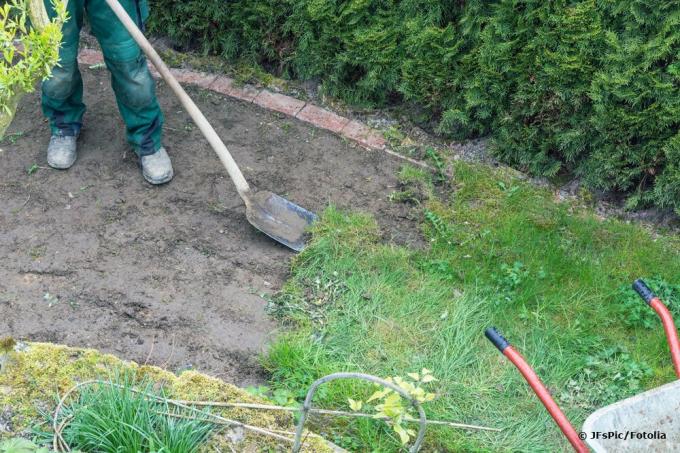
table of contents
- The simple variant for short downtimes
- With little effort to a permanent stand
- The instructions step by step
- Cut the sward
- Soil exchange
- Protection and cleanliness
- frequently asked Questions
A pool promises cooling and joy in hot summers. So that the joy actually lasts for a long time without driving the effort into the immeasurable, we reveal a very simple substructure to you.
In a nutshell
- in the case of longer idle times, the race removed
- a layer of gravel creates a clean, level surface
- Packed and kept moist, turf can be used again later
The simple variant for short downtimes
If your pool is only to be set up for a short time, i.e. for one or a few days, simple protection against damage to the valuable pool cover is sufficient. One of the following variants shields the fabric from stones, sharp pieces of wood or roots protruding from the ground:

- stable fabric garden tarpaulin
- solid weed control
- special pool mat made of foam
- Ground protection tarpaulin made of fiber-reinforced plastic
- Building protection mats made of rubber or plastic
Tip: Nevertheless, collect critical stones and other foreign objects before setting up. Even the best protection cannot prevent damage 100% and will damage itself in the long run.
With little effort to a permanent stand
As soon as you want to set up your pool for a long time, you should create a simple substructure in addition to the minimum measures already described. It is able to create a permanent basis and reliably prevent damage and also the mere slipping of the pool with all the undesirable consequences.
The tool
- spade
- Garden tarpaulin, 2 pieces
- Garden rake
- bucket
- Setting staff / straight edge
- Spirit level
The material
- fine grit
- Alternatively: sand

The instructions step by step
Here we go. You can create the substructure for your pool in no time in a few simple steps:
Cut the sward
Your lawn will start to rot after just a few days without light and oxygen. On the one hand, the plants can no longer be used even after your pool has been idle. On the other hand, bathing fun can also be immensely disturbed by a putrid smell.
- Stake out the dimensions of the pool at the planned location
- Add around 20 to 30 centimeters on all sides
- Cut the lawn in the marked area with a spade in individual sods
- Loosen and remove lawn turf
- Lay the cut lawn on a garden tarpaulin, e.g. B. under a shady bush
Tip: Especially if your pool is to stand for a long time, the cut lawn dries out over the long term. Water the sod and wrap it in the tarp used to keep it growing for at least a few days and weeks. Then the individual sods can later be used again to renaturalize the site.
Soil exchange
A frost-free substructure is certainly not required for your pool, as you knock it off and stow it away before winter anyway. However, you should Underground Prepare in such a way that neither stones nor other foreign bodies can penetrate the pool floor. In addition, this is a wonderful opportunity to create an exactly horizontal subgrade, so that the water level is later optimally horizontal within your pool.

- Dig the earth around 20 to 30 centimeters deep and store the excavated material on a tarpaulin next to turf
- Level the substrate and remove large stones, pieces of roots, etc. collect
- Fill the hole level with fine grit or sand
- Step on the filling or press it on with a board or something similar
- Peel off the top edge of the filling horizontally and evenly with the help of a lath and spirit level
Attention: Refrain from compacting the backfill with vibrating plates, rammers or the like. In addition to the split, the soil underneath is also strongly compressed and loses important properties for subsequent renaturation!
Protection and cleanliness
Finally, it is important to prepare the substructure in such a way that you can not only set up your swimming pool, but also use it properly afterwards.
- Cover the filled area with a sturdy fabric tarpaulin
- Overlap the joints neatly
- Avoid wrinkles and creases that could later affect the pool skin
- Finally, check the evenness and slope again
You have thus created the basis for setting up your pool safely and securely.
frequently asked Questions
Yes. In addition to preventing damage, the gravel also protects against rising soil moisture. In the event of direct contact with the ground, this collects below the pool and promotes mold and rot in the organic soil components.
All pool types that are built above ground without real foundations can be provided with this substructure. As soon as fixed pool shells are used or the pool is sunk into the ground, you should absolutely observe further information provided by the manufacturer.
In principle, you can also use coarse gravel as a substructure. However, you should cover it with a final layer of sand or fine grit so that large, sharp-edged stones do not come into direct contact with the actual pool skin.



